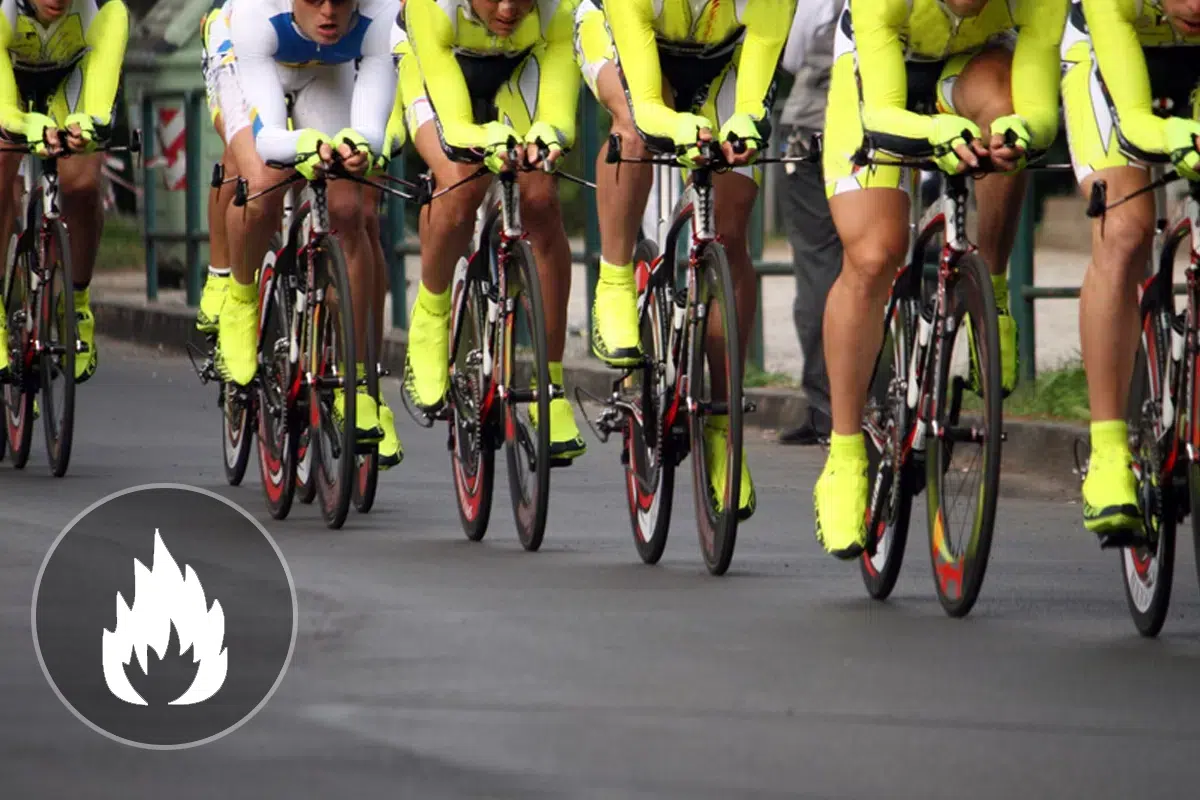Show summary Hide summary
How many calories do we burn cycling?

All you need to know about cycling Cycling
🚴 Wondering how many calories you burn cycling (road cycling), road biking or racing for 30 minutes or 1 hour? Enter your details to calculate your energy expenditure.
Discover other REGIVIA calculators:
Cycling: A few examples of energy expenditure depending on weight and activity time.
Use the table below to see how many calories you lose when you cycle!
Cycling
light effort
Expenditure in Kilocalories
| Weight | 15 minutes | 30 minutes | 1 hour |
|---|---|---|---|
| 40 kg | 42 | 84 | 168 |
| 50 kg | 53 | 105 | 210 |
| 60 kg | 63 | 126 | 252 |
| 70 kg | 74 | 147 | 294 |
| 80 kg | 84 | 168 | 336 |
| 90 kg | 95 | 189 | 378 |
Cycling
average effort
Kilocalorie expenditure
| Weight | 15 minutes | 30 minutes | 1 hour |
|---|---|---|---|
| 40 kg | 74 | 147 | 294 |
| 50 kg | 92 | 184 | 368 |
| 60 kg | 110 | 221 | 441 |
| 70 kg | 129 | 257 | 515 |
| 80 kg | 147 | 294 | 588 |
| 90 kg | 165 | 331 | 662 |
Cycling
intense effort (22-30kmh)
Kilocalorie expenditure
| Weight | 15 minutes | 30 minutes | 1 hour |
|---|---|---|---|
| 40 kg | 105 | 210 | 420 |
| 50 kg | 131 | 263 | 525 |
| 60 kg | 158 | 315 | 630 |
| 70 kg | 184 | 368 | 735 |
| 80 kg | 210 | 420 | 840 |
| 90 kg | 236 | 473 | 945 |
Cycling
very intense effort (>30kmh)
Kilocalorie expenditure
| Weight | 15 minutes | 30 minutes | 1 hour |
|---|---|---|---|
| 40 kg | 147 | 294 | 588 |
| 50 kg | 184 | 368 | 735 |
| 60 kg | 221 | 441 | 882 |
| 70 kg | 257 | 515 | 1029 |
| 80 kg | 294 | 588 | 1176 |
| 90 kg | 331 | 662 | 1323 |
See detailed calculations and metabolic equivalent for cycling
All you need to know about cycling Cycling
FIND OUT MORE ABOUT CYCLING
Cycling is an excellent way to lose weight and have fun at the same time. Cycling is booming, whether as a physical activity or as a means of getting around! For city dwellers who no longer want to pay €2500 a year for the upkeep of their beautiful car and sculpt their dream body on the way to work, the choice is quickly made: cycling offers all these advantages combined (health and economy).
Cycling also has a number of fitness benefits: it increases breathing capacity, is easy on the joints and helps strengthen the back.
But don’t forget to be seen, and don’t forget to think about your safety! That’s why you should be cycling in bright colours (ideally with a fluorescent yellow waistcoat), and don’t forget to wear a helmet. It’s worth remembering that 2-wheelers are the victims of many accidents in urban areas, which could often be avoided by driving more responsibly and with more forethought.
As well as being an excellent way to lose weight and tone up, cycling also has a positive impact on mental health. Cycling in the fresh air, whether on the way to work or for a leisurely ride, helps to reduce stress and improve mood. It’s an effective way of disconnecting from the daily routine and enjoying the benefits of nature.
What’s more, cycling is an activity that can be adapted to all fitness levels. Whether you’re a beginner or an experienced cyclist, you can adjust the intensity of your ride to suit your abilities and your goals. It’s an inclusive activity that can be enjoyed at any age.
Finally, don’t forget the importance of equipment. A well-maintained bike that’s suited to your size and use will enable you to ride safely and efficiently. Don’t forget to buy useful accessories such as a tyre repair kit, a bicycle pump and a quality lock.
Some benefits of cycling :
Regular cycling has a number of benefits for both the mind and body. Cycling outdoors allows you to :
- You can work on your endurance, heart muscles and breathing
- Improves venous circulation in the legs and relieves heavy legs
- Cycling helps to strengthen muscles and bones
- Cycling helps reduce stress and anxiety
Finally, cycling is an excellent way of helping to protect the environment. By choosing to cycle rather than drive, you’re reducing your carbon footprint, helping to cut air pollution and helping to reduce road traffic. Cycling is not only good for your health and your wallet, it’s also good for our planet.
How to calculate the number of calories burned when cycling
The result displayed is expressed in Kcal and is calculated using the MET (Metabolic Equivalent of Task). The MET for each activity is the result of statistical data and cannot therefore be interpreted as an exact calculation, but rather as an estimate that takes into account the MET value and the ratio between the time spent doing an activity and the weight of the individual.
For example: The MET value for cycling with a light effort (a walk with the family) is 4. This means that a person who cycles consumes 4 times more energy than when resting during the session.
MET values for different levels of cycling intensity
- Light effort MET = 4
- Medium-effort cycling MET = 7
- Intense effort cycling (22-30km/h) MET = 10
- Cycling Very intense effort (> 30km/h) MET = 14
Discover the detailed formula to calculate your daily energy expenditure while cycling
Consumption in Kcal per minute = (METs*3.5*Weight in kilos)/200
This gives for a 60kg person cycling (at low intensity) for 30 minutes:
Consumption in Kcal per minute = (4*3.5*60)/200 = 4.2 Kcal/min
So for 30 minutes = 4.2*30 = 126 kcal for 30 minutes
For the same amount of time and with an intense effort of between 22 and 30km/h, the same cyclist will expend around 315 kilocalories.
All sports in detail!



















































